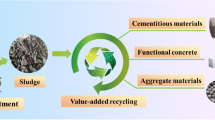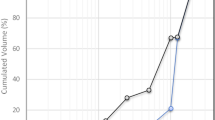Abstract
The qualified green lightweight aggregate (LWA) was successfully prepared from steel mill sludge (SMS) and fly ash (FAS) in one step using the cost-effective sintering method. The effects of the ratio of FAS and SMS, sintering temperature, and sintering time on the performance of LWA were studied. The results show that the optimal LWA has bulk density of 721 kg m−3, compressive strength of 14.0 MPa, and water absorption of 12.6% under the follow optimized conditions: FAS and SMS mixed at a ratio of 8:2 at the sintering temperature of 1150 °C for 25 min. The mechanisms of mineralogical phases and microstructures formation were proposed. The microstructure of qualified LWA was characterized by a dense surface and a porous structure inside. The presence of mullite and anorthite phase can improve the strength of aggregate.











Similar content being viewed by others
References
Alloway BJ, Jackson AP (1991) The behaviour of heavy metals in sewage sludge-amended soils. Sci Total Environ 100:151–176. https://doi.org/10.1016/0048-9697(91)90377-Q
Verlicchi P, Aukidy MAL, Zambello E (2012) Occurrence of pharmaceutical compounds in urban wastewater: Removal, mass load and environmental risk after a secondary treatment—a review. Sci Total Environ 429:123–155. https://doi.org/10.1016/j.scitotenv.2012.04.028
Appels L, Degrève J, Bruggen BVD, Impe JV, Dewil R (2010) Influence of low temperature thermal pre-treatment on sludge solubilisation, heavy metal release and anaerobic digestion. Bioresour Technol 101:5743–5748. https://doi.org/10.1016/j.biortech.2010.02.068
Houillon G, Jolliet O (2005) Life cycle assessment of processes for the treatment of wastewater urban sludge: energy and global warming analysis. J Clean Prod 13:287–299. https://doi.org/10.1016/j.jclepro.2004.02.022
Yang G, Zhang GM, Wang HC (2018) Current state of sludge production, management, treatment and disposal in China. Water Res 78:60–73. https://doi.org/10.1016/j.watres.2015.04.002
Das B, Prakash S, Reddy PSR, Misra VN (2007) An overview of utilization of slag and sludge from steel industries. Resour Conserv Recy 50:40–57. https://doi.org/10.1016/j.resconrec.2006.05.008
Gomez V, Wright K, Esquenazi GL, Barron AR (2019) Microwave treatment of a hot mill sludge from the steel industry: an route to recycling an industrial waste. J Clean Prod 207:182–189. https://doi.org/10.1016/j.jclepro.2018.08.294
Mocellin J, Mercier G, Morel JL, Blais JF, Simonnot MO (2005) Factors influencing the Zn and Mn extraction from pyrometallurgical sludge in the steel manufacturing industry. J Environ Manage 158:48–54. https://doi.org/10.1016/j.jenvman.2015.04.039
Malliou O, Katsioti M, Georgiadis A, Katsiri A (2007) Properties of stabilized/solidified admixtures of cement and sewage sludge. Cement Concrete Comp 29:55–61. https://doi.org/10.1016/j.cemconcomp.2006.08.005
Weng CH, Lin DF, Chiang PC (2003) Utilization of sludge as brick materials. Adv Environ Res 7:679–685. https://doi.org/10.1016/S1093-0191(02)00037-0
Mun KJ (2007) Development and tests of lightweight aggregate using sewage sludge for nonstructural concrete. Constr Build Mater 21:1583–1588. https://doi.org/10.1016/j.conbuildmat.2005.09.009
Lynn CJ, Dhir RK, Ghataora GS, West RP (2015) Sewage sludge ash characteristics and potential for use in concrete. Constr Build Mater 98:767–779. https://doi.org/10.1016/j.conbuildmat.2015.08.122
BS (2002) EN 13055. Part 1: Lightweight aggregates for concrete, mortar and grout. Lightweight Aggregates. British Standards Institution, London
BS (2013) EN 206. Part 1: Specification, performance, production and conformity. Concrete. British Standards Institution, London
Meyer C (2009) The greening of the concrete industry. Cement Concrete Comp 31:601–605. https://doi.org/10.1016/j.cemconcomp.2008.12.010
Li B, Ling TC, Qu L, Wang Y (2016) Effects of a two-step heating process on the properties of lightweight aggregate prepared with sewage sludge and saline clay. Constr Build Mater 114:119–126. https://doi.org/10.1016/j.conbuildmat.2016.03.159
Corrochano BG, Azcárate JA, Rodas M (2009) Characterization of lightweight aggregates manufactured from washing aggregate sludge and fly ash. Resour Conserv Recy 53:571–581. https://doi.org/10.1016/j.resconrec.2009.04.008
Corrochano BG, Azcárate JA, Rodríguez L, Lorenzo AP, Torío MF, Ramos JJT, Corvinos MD, Muro C (2016) Valorization of washing aggregate sludge and sewage sludge for lightweight aggregates production. Constr Build Mater 116:252–262. https://doi.org/10.1016/j.conbuildmat.2016.04.095
Cheeseman CR, Virdi GS (2005) Properties and microstructure of lightweight aggregate produced from sintered sewage sludge ash. Resour Conserv Recy 45:18–30. https://doi.org/10.1016/j.resconrec.2004.12.006
Tuan BLA, Hwang CL, Lin KL, Chen YY, Young MP (2013) Development of lightweight aggregate from sewage sludge and waste glass powder for concrete. Constr Build Mater 47:334–339. https://doi.org/10.1016/j.conbuildmat.2013.05.039
Lau PC, Teo DCL, Mannan MA (2017) Characteristics of lightweight aggregate produced from lime-treated sewage sludge and palm oil fuel ash. Constr Build Mater 152:558–567. https://doi.org/10.1016/j.conbuildmat.2017.07.022
Liu JZ, Li YS (2012) Preparation and microstructure of green ceramsite made from sewage sludge. J Wuhan Univ Technol 27: 149–153. http://www.cnki.com.cn/Article/CJFDTotal-WLGY201201031.htm
Wang XR, Jin YY, Wang ZY, Nie YF, Huang QF, Wang Q (2009) Development of lightweight aggregate from dry sewage sludge and coal ash. Waste Manage 29:1330–1335. https://doi.org/10.1016/j.wasman.2008.09.006
Corrochano BG, Azcárate JA, Rodas M, Luque FJ, Barrenechea JF (2010) Microstructure and mineralogy of lightweight aggregates produced from washing aggregate sludge, fly ash and used motor oil. Cement Conc Comp 32:694–707. https://doi.org/10.1016/j.cemconcomp.2010.07.014
Baykal G, Döven AG (2000) Utilization of fly ash by pelletization process; theory, application areas and research results. Resour Conserv Recy 30:59–77. https://doi.org/10.1016/S0921-3449(00)00042-2
Thomas J, Harilal B (2016) Mechanical properties of cold bonded quarry dust aggregate concrete subjected to elevated temperature. Constr Build Mater 125:724–730. https://doi.org/10.1016/j.conbuildmat.2016.08.093
Gesoğlu M, Özturan T, Güneyisi E (2007) Effects of fly ash properties on characteristics of cold-bonded fly ash lightweight aggregates. Constr Build Mater 21:1869–1878. https://doi.org/10.1016/j.conbuildmat.2006.05.038
Hiramatsu Y, Oka Y (1966) Determination of the tensile strength of rock by a compression test of an irregular test piece. Int J Rock Mech Min 3:89–90. https://doi.org/10.1016/0148-9062(66)90002-7
Liu MW, Wang CZ, Bai Y, Xu G (2018) Effects of sintering temperature on the characteristics of lightweight aggregate made from sewage sludge and river sediment. J Alloy Compd 748:522–527. https://doi.org/10.1016/j.jallcom.2018.03.216
Ahmaruzzaman M (2010) A review on the utilization of fly ash. Prog Energ Combust 36:327–363. https://doi.org/10.1016/j.pecs.2009.11.003
Qi YF, Yue QY, Han SX, Yue M, Gao BY, Yu H, Shao T (2010) Preparation and mechanism of ultra-lightweight ceramics produced from sewage sludge. J Hazard Mater 176:76–84. https://doi.org/10.1016/j.jhazmat.2009.11.001
Park YJ, Moon SO, Heo J (2003) Crystalline phase control of glass ceramics obtained from sewage sludge fly ash. Ceram Int 29:223–227. https://doi.org/10.1016/S0272-8842(02)00109-8
Zhu P, Wang LY, Hong D, Qian GR, Zhou M (2012) A study of making synthetic oxy-fluoride construction material using waste serpentine and kaolin mining tailings. Int J Miner Process 104–105:31–36. https://doi.org/10.1016/j.minpro.2011.12.003
Franus M, Franus DB, Wdowin M (2016) Utilization of sewage sludge in the manufacture of lightweight aggregate. Environ Monit Assess 188:10. https://doi.org/10.1007/s10661-015-5010-8
Huang ZH, Huang SF, Leng XF, Sun HR, Fang MH, Liu YG (2009) Phase design of anorthite/mullite composite refractories. Rare Metal Mat Eng 38:1252–1254. https://doi.org/10.3321/j.issn:1002-185X.2009.z2.333
Forray FL, Drouet C, Navrotsky A (2004) Thermochemistry of yavapaiite KFe(SO4)2: formation and decomposition. Cosmochim Ac 69:2133–2140. https://doi.org/10.1016/j.gca.2004.10.018
Xu GR, Zou JL, Li GB (2008) Ceramsite made with water and wastewater sludge and its characteristics affected by SiO2 and Al2O3. Environ Sci Technol 42:7417–7423. https://doi.org/10.1021/es801446h
Johari I, Said S, Hisham B, Bakar B, Ahmad ZA (2010) Effect of the change of firing temperature on microstructure and physical properties of clay bricks from Beruas (Malaysia). Sci Sinter 42:245–254. https://doi.org/10.2298/SOS1002245J
Acknowledgements
This work was supported by the National Natural Science Foundation of China-the joint research fund of China Bao-Wu Iron and Steel Group Co., Ltd. (Grant No. U1860108, U1860203), the National Natural Science Foundation of China (Nos. 52022054; 51974181), the Shanghai Rising-Star Program (19QA1403600), and the Program for Professor of Special Appointment (Eastern Scholar) at Shanghai Institutions of Higher Learning (TP2019041) for financial support.
Author information
Authors and Affiliations
Corresponding authors
Additional information
Publisher's Note
Springer Nature remains neutral with regard to jurisdictional claims in published maps and institutional affiliations.
Rights and permissions
About this article
Cite this article
Hong, J., Chen, Z., Huang, Y. et al. Fabrication and characterization of lightweight aggregate prepared from steel mill sludge in one step. J Mater Cycles Waste Manag 24, 1072–1082 (2022). https://doi.org/10.1007/s10163-022-01385-x
Received:
Accepted:
Published:
Issue Date:
DOI: https://doi.org/10.1007/s10163-022-01385-x




